
views
Estimating Your Income
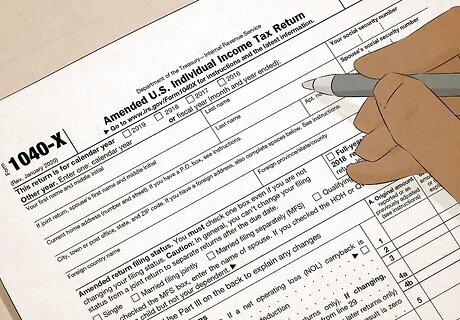
Use the correct form. In order to determine your taxable income, start by selecting the correct IRS 1040 form to file with. See the IRS website for more information. Note that there are certain types of income, like long-term capital gains, qualified dividend income, Section 1250 depreciation recapture, and self-employment income, that will be taxed at a different rate than your marginal federal tax rate

Estimate your adjusted gross income. Your adjusted gross income will be the amount you will make in the current year, minus any pre-tax adjustments to your income, like deductible traditional IRA or 401 K contributions. Check your pay stubs, last year's W-2 or last year's tax return to get a more accurate estimate for the money you're likely to make.
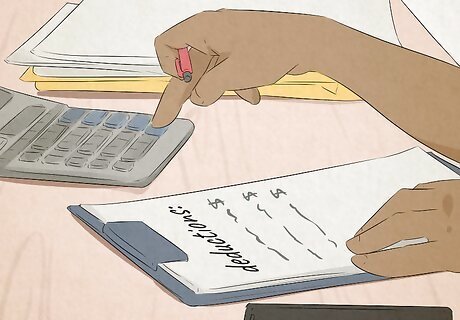
Figure out your deductions. If you plan to itemize your deductions, you may want to do a general estimate based on last year's return, if your expenses are similar. If you don't plan to itemize your deductions, determine your standard deduction amount based on official IRS standards. Standard deduction amounts change from year to year, and you'll always need to double-check against the official IRS numbers.

Subtract your deductions. Once you've subtracted your deductions from your adjusted gross income, the result is your taxable income. You will use this figure to determine your tax bracket.
Choosing a Bracket
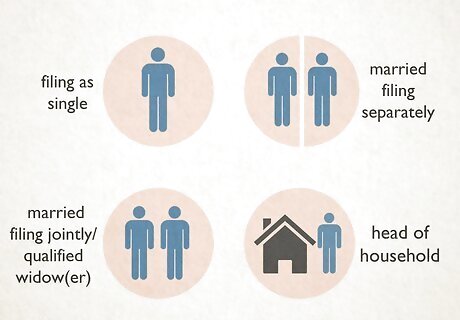
Determine your filing status. The IRS establishes different tax bracket depending on your filing status. Your filing status is where you indicate whether you are filing as a single person, a married couple filing jointly, a married couple filing separately, a qualified widow, or head of household. Figure out your filing status, then scroll down until you see the taxable income amount you calculated in the first section, and learn what percentage of that income will be taxed.
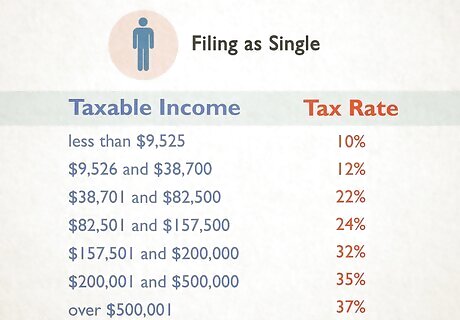
Determine if you are filing as single. Use the "Single" filing status if you are unmarried, divorced, or legally separated as of the last day of the current tax year. If your taxable income is: Less than $9,525, your tax bracket is 10% Between $9,526 and $38,700, your tax bracket is 12% Between $38,701 and $82,500, your tax bracket is 22% Between $82,501 and $157,500, your tax bracket is 24% Between $157,501 and $200,000, your tax bracket is 32% Between $200,001 and $500,000, your tax bracket is 35% Over $500,001, your tax bracket is 37%
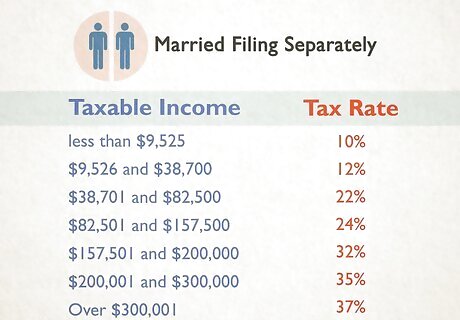
Figure out if you are filing as married filing separately. If you are married but will not file taxes with your spouse, use this filing status. If your taxable income is: Less than $9,525, your tax bracket is 10% Between $9,526 and $38,700, your tax bracket is 12% Between $38,701 and $82,500, your tax bracket is 22% Between $82,501 and $157,500, your tax bracket is 24% Between $157,501 and $200,000, your tax bracket is 32% Between $200,001 and $300,000, your tax bracket is 35% Over $300,001, your tax bracket is 37%
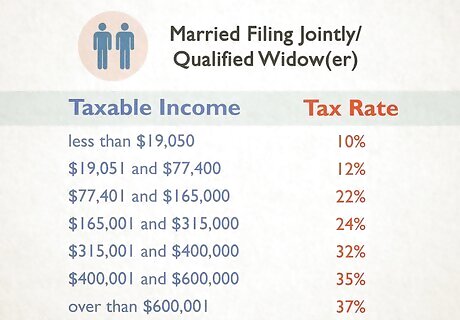
Figure out if you are filing as married filing jointly or as a qualified widow(er). Use the "Married" filing status if you plan to file your taxes jointly with your spouse. This means you will use your combined income as the determination of your tax bracket. You can also use this bracket if your spouse died during the current tax year. Use the "Qualified Widow(er)" if your spouse died in the previous tax year, you filed jointly the year before, and have at least one dependent. If your taxable income is: Less than $19,050, your tax bracket is 10% Between $19,051 and $77,400, your tax bracket is 12% Between $77,401 and $165,000, your tax bracket is 22% Between $165,001 and $315,000, your tax bracket is 24% Between $315,001 and $400,000, your tax bracket is 32% Between $400,001 and $600,000, your tax bracket is 35% Over $600,001, your tax bracket is 37%
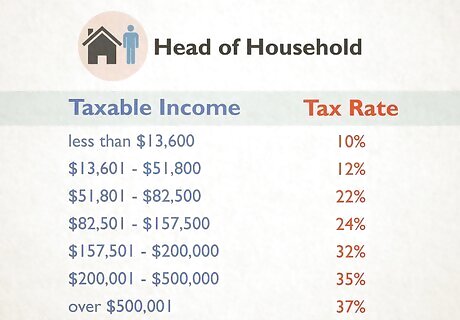
Determine if you are filing as a head of household. Use the "Head of Household" filing status if you are unmarried, have at least one dependent living with you and if you provide over half of the money required to keep up your household. You can also file for this if you provide over half the income for the household, have at least one dependent and your spouse did not live with you for the last six months of the year. If your taxable income is: Less than $13,600, your tax bracket is 10% Between $13,601 and $51,800, your tax bracket is 12% Between $51,801 and $82,500, your tax bracket is 22% Between $82,501 and $157,500, your tax bracket is 24% Between $157,501 and $200,000, your tax bracket is 32% Between $200,001 to $500,000, your tax bracket is 35% Over $500,001, your tax bracket is 37%



















Comments
0 comment